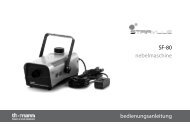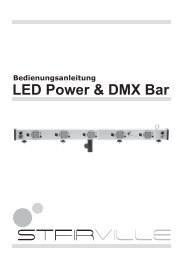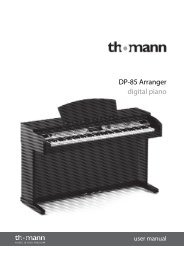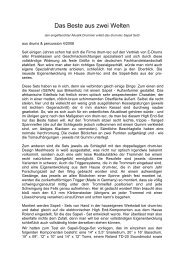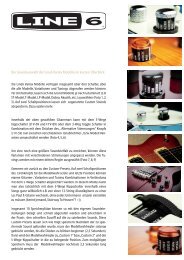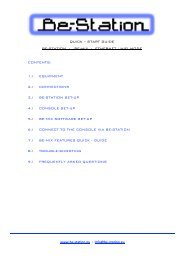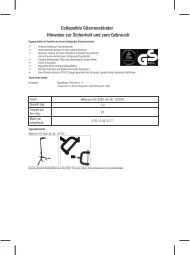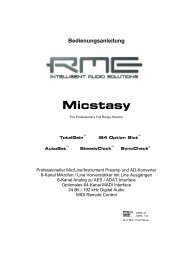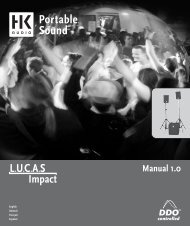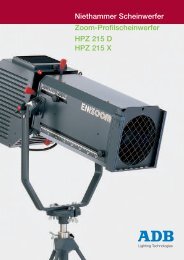You also want an ePaper? Increase the reach of your titles
YUMPU automatically turns print PDFs into web optimized ePapers that Google loves.
8:7 Introduction to BFD2 automation<br />
Overview<br />
BFD2 allows you to change most of its controls over time by using hardware controllers or messages from your host. MIDI continuous<br />
controllers (MIDI CCs), MIDI notes and host automation parameters can be assigned to the available software controls.<br />
MIDI CCs and host automation<br />
MIDI CCs and host automation both have their own set of advantages and disadvantages. BFD2 supports both methods so it’s<br />
entirely up to you which to use.<br />
MIDI continuous controllers allow a maximum resolution of 128 steps. While RPN and NRPN commands allow higher resolutions,<br />
it is relatively rare for hardware MIDI controllers to support them, because of the complexity required to program these functions.<br />
Host automation, on the other hand, allows far higher resolution for continuous parameter control. The amount of resolution can<br />
vary depending on the capabilities of the host and the plugin format, as well as any hardware control surfaces used. It tends to be<br />
anything from 14-bit (16,384 steps) to 32-bit floating point (effectively continuous).<br />
While it is easy to ‘draw’ host automation curves onto track lanes in your host, hardware controllers for this type of automation<br />
tend to be expensive and specialized.<br />
Also, the controls available for plugins on these hardware automation devices tends to be rather fiddly and uncustomizable,<br />
usually having to page through many parameters to reach the one you need at any one time. MIDI controllers tend to be easier<br />
to customize to your needs, and because they are cheaper they make it affordable to have more dedicated hardware controls at<br />
once.<br />
MIDI note automation<br />
BFD2 allows you to map MIDI notes to software controls. This is very useful for button type controls. You can also assign a continuous<br />
control such as a fader or knob to a MIDI note – the note toggles the control between minimum and maximum values.<br />
Parameter MIDI learn function in the status bar<br />
Virtually all BFD2 faders, knobs and buttons can be assigned to MIDI quickly and intuitively by using the controller learn function<br />
in the BFD2 Status bar. This function is covered in section 1:5.<br />
Automation mapping page<br />
The automation mapping page gives you a complete overview of all MIDI assignments, as well as the ability to assign controls<br />
manually to MIDI CCs, MIDI notes and host automation parameters.<br />
While you can assign MIDI CCs and notes to BFD2 controls via the controller learn function in the status bar, the automation<br />
mapping page is the only area in BFD2 that allows you to assign host automation parameters to the software controls.<br />
Multiple mappings<br />
BFD2 allows you to assign any one software parameter to two possible automation parameters:<br />
1. ONE MIDI CC or MIDI note<br />
2. ONE host automation parameter<br />
It is inadvisable to send MIDI and host automation values at the same time, because the BFD2 parameter would keep ‘jumping’<br />
between values sent by the two sets of messages.<br />
Setting a unique MIDI channel for MIDI automation<br />
You can specify a separate MIDI channel for MIDI automation events, by using the Controller MIDI channel setting in the BFD2<br />
Session preferences.<br />
This is useful because if you want to assign a lot of buttons to MIDI notes, for example, you may run out of notes because they<br />
are already used by articulation assignments and Grooves (although you can, as discussed elsewhere, assign the Groove engine<br />
to its own MIDI channel too).<br />
This MIDI channel setting also applies to the controller learn function. Once set, BFD2 receives MIDI only on the specified channel<br />
when making controller learn assignments.<br />
If you create some MIDI automation assignments and subsequently change the Controller MIDI channel setting, all current assignments<br />
receive on the new MIDI channel, regardless of what channel was used when first creating the mappings.<br />
1 1



